Table of contents
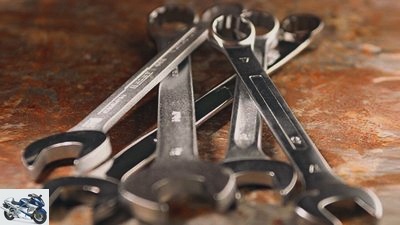
jkuenstle.de

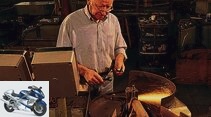


11 pictures

wolf
1/11
Step 7: Now it’s the turn of the mouth. The worker puts the keys in a cassette and makes sure that all keys are inserted evenly. Now the mouths are milled – 900 pieces per hour.
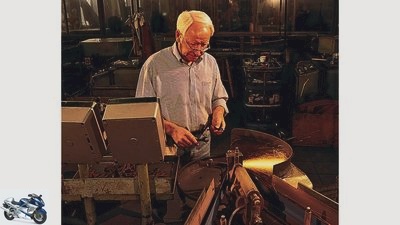
wolf
2/11
Step 5: Then the hole is punched (not in the picture). After the normalizing furnace (step 9) it goes to the plied. The employee works on a belt grinder to ensure that the burr is removed from the ring.
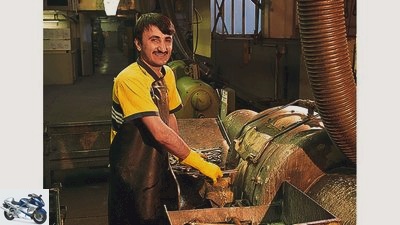
wolf
3/11
Step 8: Now come the keys to hardening and vibratory finishing. Then the colleague grinds the heads from both sides between two slip rings. This serves as preparation for polishing.

jkuenstle.de
4/11
High-quality tools such as these wrenches are manufactured, for example, by the German manufacturer Hazet in Remscheid.
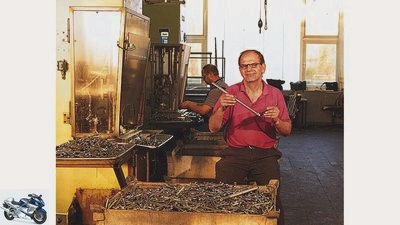
wolf
5/11
Step 6: The next step is called clearing. The worker presses the double hexagon into the ring on a press with a broach (which he is holding here in his right hand).
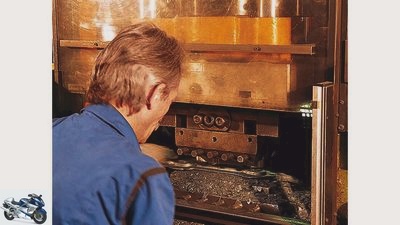
wolf
6/11
Step 4: The tool is now completely forged. This is followed by trimming. The colleague removes the burr from the blank (in the picture it is a half-inch ratchet) with a 100-ton press.
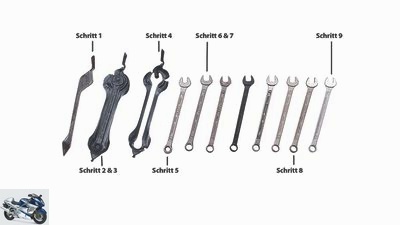
wolf
7/11
And finally, here is an overview of how the finished key is created step by step from the blank.
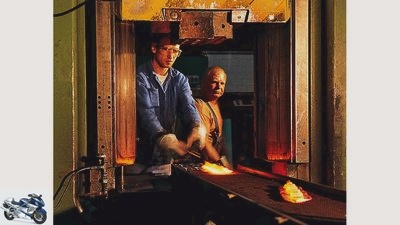
wolf
8/11
Step 3: The man in the dungarees heats the split piece in an oven at 1200 degrees. Then the bespectacled blacksmith hits the part five times with the blacksmith’s hammer.
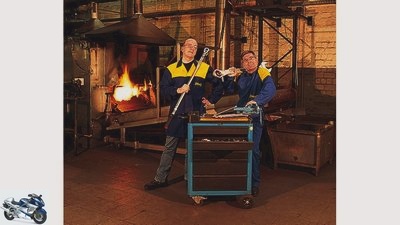
wolf
9/11
Step 9: Finally, the keys are nickel-plated and chrome-plated. The editor and photographer dedicate themselves to the somewhat larger calibers: torque wrench 300–800 Nm, 80 mm open-end wrench.

wolf
10/11
Step 1: This Hazet worker is working on a press (in the background). The punched small pieces of gap from a six meter long and 220 kilogram heavy plate made of chrome-vanadium steel.
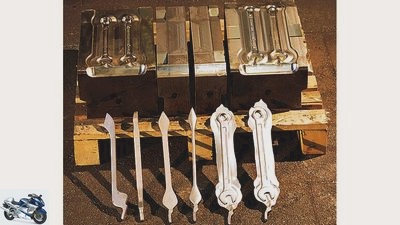
wolf
11/11
Step 2: This is a die, a hollow form, in which the split piece (left) is forged into a blank. The process is called drop forging. One die holds around 15,000 forgings.
counselor
workshop
Report: tool production
Report: tool production
This is how wrenches are made
Anyone who sees at the German manufacturer Hazet how complex it is to produce good tools will never be surprised at the prices again.
Klaus Herder
02/04/2010
Remscheid is in the Bergisches Land. This is one of the rainiest areas in Germany. The Remscheid team could have made a virtue out of necessity and built up a flourishing umbrella industry. But they don’t, because in addition to water power, there was always a lot of wood and iron ore there. Iron and steel could already be produced with it in the Middle Ages. Because farmers and artisans also lived in the area, the metal was used to make hoes, scythes, saws and files. This is how Remscheid became the center of the German tool industry. Today the three leading German tool manufacturers produce in the region. One of them is Hazet. The name is the written out form of the letters HZ. These are the initials of the blacksmith Hermann Zerver. He started with fittings for railway wagons in 1868, today around 500 employees work in three plants. The program includes around 5500 products. MOTORRAD took a closer look at the production of a combination wrench. You can see how high-quality tools are created in detail in the photo show – earlier in this article.
Buy complete article

Report: tool production
This is how wrenches are made
2 pages) as PDF
€ 2.00
Buy now
Related articles
-
Report clothing and accessories production
Stefan Wolf 16 pictures Stefan Wolf 1/16 Phan Thi Ha (30) is the boss of 60 employees in the 2160 m², multi-storey KIDO raw materials warehouse…
-
Cook 8th pictures Cook 1/8 Solid screwdrivers with a handy shaft are preferable to tools with bits. Cook 2/8 The standard on-board tools are replaced by…
-
Basic screwdriver tip for the 1st tool collection
Ralf Petersen 13th pictures Ralf Petersen 1/13 This screwdriver tip is about the most elementary basics. Everyone started out very small and simple. For…
-
Motorcycle production at Bimota
Jahn counselor traffic & business Motorcycle production at Bimota This is how one of the smallest manufacturers in the world produces Motorcycle…
-
Product test inexpensive tool case
mps photo studio counselor workshop Product test inexpensive tool case Product test: tool case How good are cheap tool cases really 100 parts for 100…
-
Harley-Davidson: Indian production is discontinued
Harley-Davidson counselor traffic & business Harley-Davidson: Indian production is discontinued Harley-Davidson ceases production in India Street models…
-
Report of VHS mechanics courses
Blacksmith 7th pictures Blacksmith 1/7 Quite a few motorcyclists give up quickly to repairs or even simple maintenance work. Ralf Petersen’s mechanics…
-
Suter MMX 500 in the PS driving report
Borner 28 pictures Suter 1/28 Suter MMX 500 in the PS driving report. Suter 2/28 As the only magazine in Germany, PS was allowed to test the Suter MMX…
-
Quarter-inch tool sets put to the test
Herder counselor workshop Quarter-inch tool sets put to the test Product test: quarter-inch tool sets 16 handy tool sets put to the test When things get…
-
Report: This is how Triumph produces motorcycles
triumph motorcycles Report: This is how Triumph produces motorcycles Report: This is how Triumph produces motorcycles Where and how are the two and three…